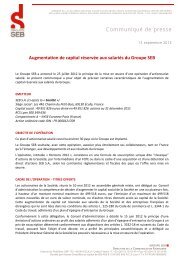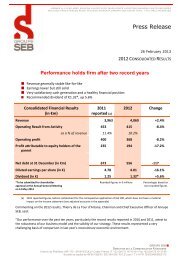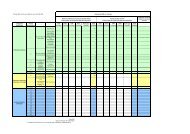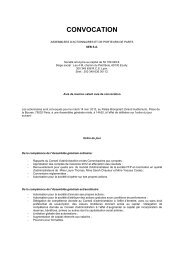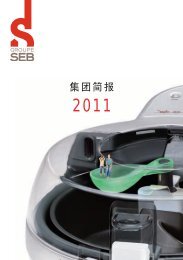Financial Report and Registration Document 2010 - Groupe Seb
Financial Report and Registration Document 2010 - Groupe Seb
Financial Report and Registration Document 2010 - Groupe Seb
Create successful ePaper yourself
Turn your PDF publications into a flip-book with our unique Google optimized e-Paper software.
1<br />
GROUPE SEB IN <strong>2010</strong><br />
INDUSTRIAL STRATEGY<br />
INDUSTRIAL STRATEGY<br />
The Group’s industrial strategy aims to continuously improve competitive<br />
performance <strong>and</strong> quality over the long term. The French <strong>and</strong> international<br />
production plan is deployed according to three major lines:<br />
Europe-based manufacturing for products when economies of scale<br />
are feasible <strong>and</strong> where the Group is a market leader, protecting its own<br />
product concepts using specifi c technologies for products (enabling a<br />
better product mix <strong>and</strong> justifying higher prices) or for processes (allowing<br />
a decrease in the cost price);<br />
use of its own plants outside Europe for economic mass-production where<br />
the Group wishes to retain control of its specific technologies in products<br />
<strong>and</strong> processes – these same factories also make products destined for<br />
local markets;<br />
sourcing of certain basic everyday products or articles in which the Group<br />
cannot exploit economies of scale.<br />
In Europe, the Group’s competitiveness involves expertise <strong>and</strong> technology<br />
centres. Product expertise centres bring together the specifi c expertise<br />
for a core activity or product category in research <strong>and</strong> development,<br />
industrialization <strong>and</strong> production. Technological centres reinforce product<br />
centres in key cross-disciplinary technologies such as materials, plastics,<br />
heating elements or electronics. Also present in industrial sites, project<br />
platforms comprise marketing, research <strong>and</strong> sourcing teams in charge of<br />
creating product offers.<br />
The Group’s industrial facility included a total of 24 industrial sites in<br />
<strong>2010</strong> (1) which produce 70% of products sold worldwide. The other 30%<br />
are outsourced, in particular to China. More specifically, the <strong>2010</strong> breakdown<br />
of production was as follows:<br />
LOCATION OF SALES PRODUCTION<br />
Europe 40%<br />
In <strong>2010</strong>, contrary to 2009, the operations of the Group’s European plants<br />
benefited from low inventories in retail distribution <strong>and</strong> the good performance<br />
<strong>and</strong>/or recovery of consumption in numerous countries, with a very<br />
favourable impact on volumes. Barring a few exceptions, the plants were<br />
in a rather good, or even very good position, in relation to absorption of<br />
costs <strong>and</strong> targeted <strong>and</strong> specifi c actions were carried out in less loaded<br />
sites (production transfers, in particular).<br />
To ensure <strong>and</strong> optimise the competitiveness of its industrial capacity,<br />
<strong>Groupe</strong> SEB constantly upgrades its plants, taking account of the economic<br />
reality of markets: adjustment of volumes, refocusing of production <strong>and</strong>/<br />
or reduction of operating costs if necessary, greater use of sourcing<br />
according to needs, in addition to manufacturing capacity upgrades to meet<br />
increasingly strong dem<strong>and</strong> as is currently the case in China. For example,<br />
the extension of buildings on the Wuhan (Supor) site dedicated to cookware<br />
will allow the Group to double production capacity in 2011; the upgrade<br />
process of the new Shaoxing plant, specialised in small electrical appliances,<br />
was signifi cantly accelerated to meet booming dem<strong>and</strong> in the Chinese<br />
market. At the same time, the Group decided to reintegrate in a number of<br />
Chinese plants part of the production that had been outsourced to Chinese<br />
subcontractors (kettles, in particular). Productivity plans are first deployed<br />
throughout plants in China in order to gradually reach Group st<strong>and</strong>ards.<br />
Ultimately, the combination of sustained industrial operations <strong>and</strong> the<br />
productivity actions implemented led to genuine improvement in the Group’s<br />
industrial performance in <strong>2010</strong>.<br />
The Group has also introduced a global Supply Chain Management system<br />
intended to rationalize stocks of fi nished products, optimize the quality<br />
of these stocks <strong>and</strong> implement a process to improve customer service.<br />
The actions undertaken resulted in significant improvements of all ratios in<br />
the last three years with, in particular, a clear improvement in the inventories<br />
of low turnover products, major reduction in supply chain costs (transports<br />
<strong>and</strong> warehouses) <strong>and</strong> major progress in sales forecasts.<br />
1<br />
Sourced 30%<br />
China 20%<br />
South America 8%<br />
USA 2%<br />
(1) 26 in March 2011 (2 Imusa sites).<br />
GROUPE SEB<br />
FINANCIAL REPORT AND REGISTRATION DOCUMENT <strong>2010</strong><br />
9









